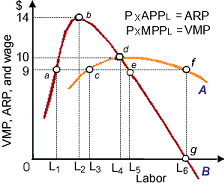This purely competitive firm’s demand as in given figure for labor corresponds to: (1) line segment ab. (2) line segment bd. (3) line segment be (4) line segment df. (5) line segment dg.

How can I solve my Economics problem? Please suggest me the correct answer.